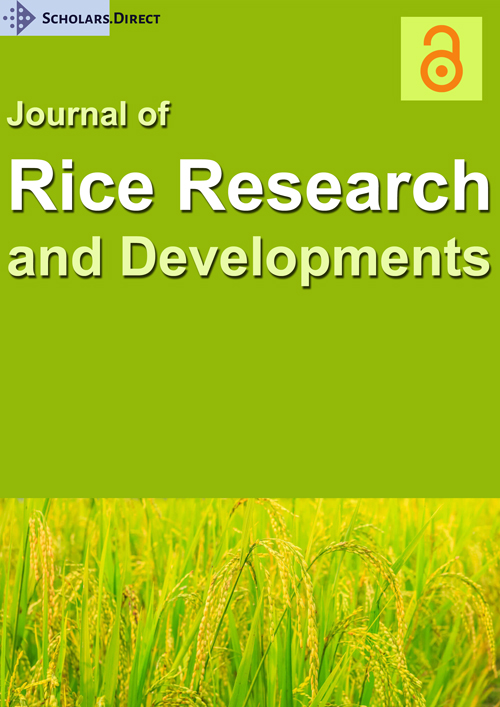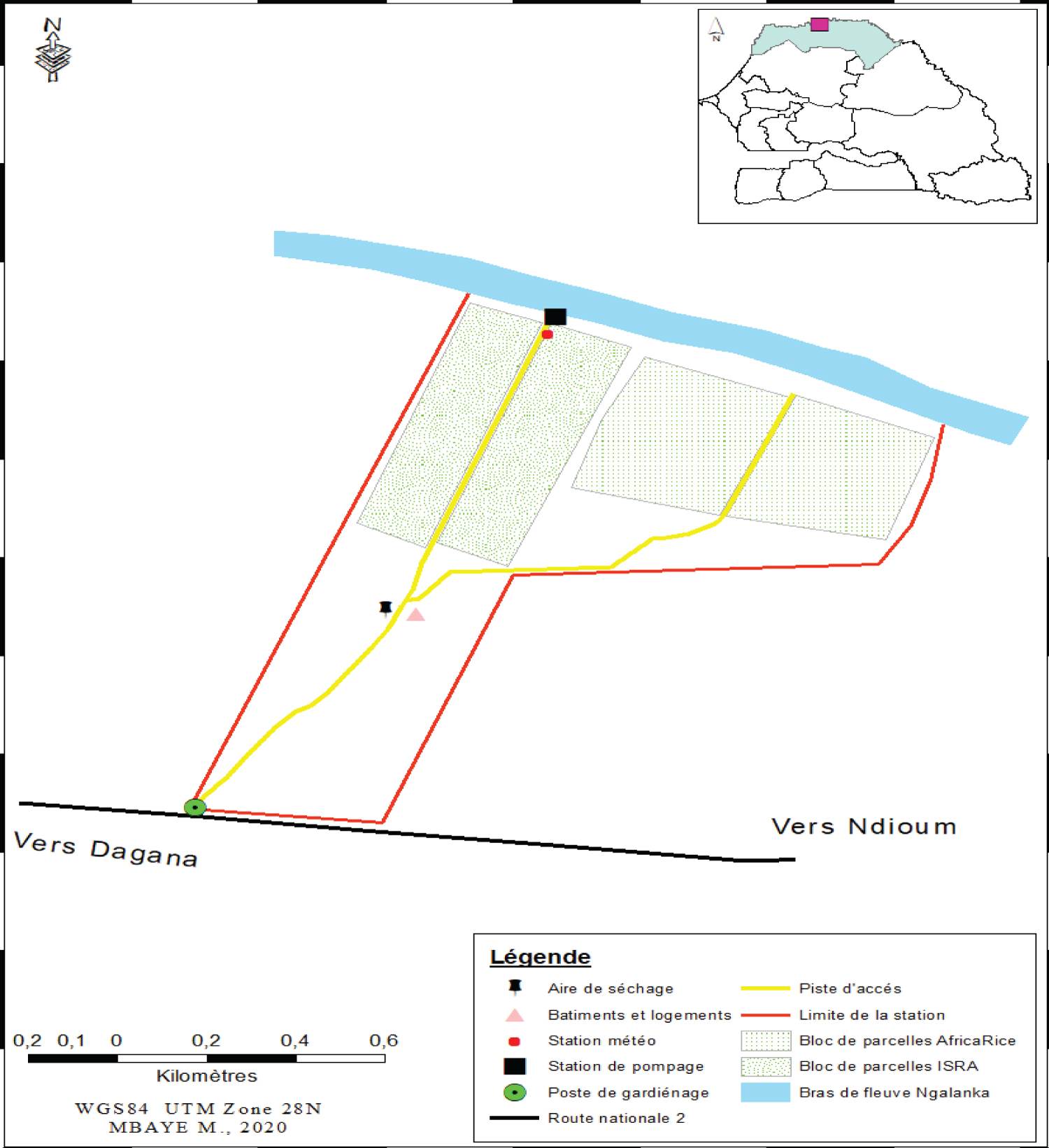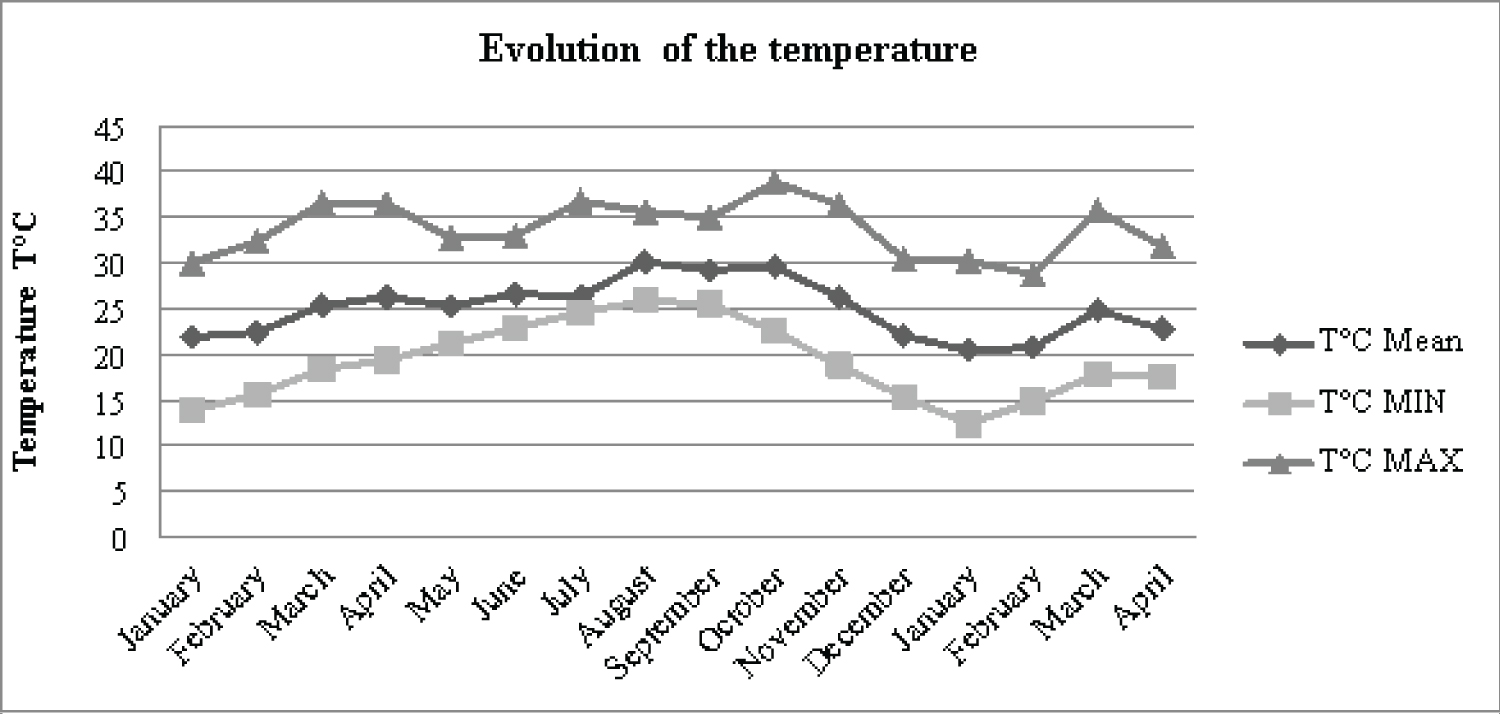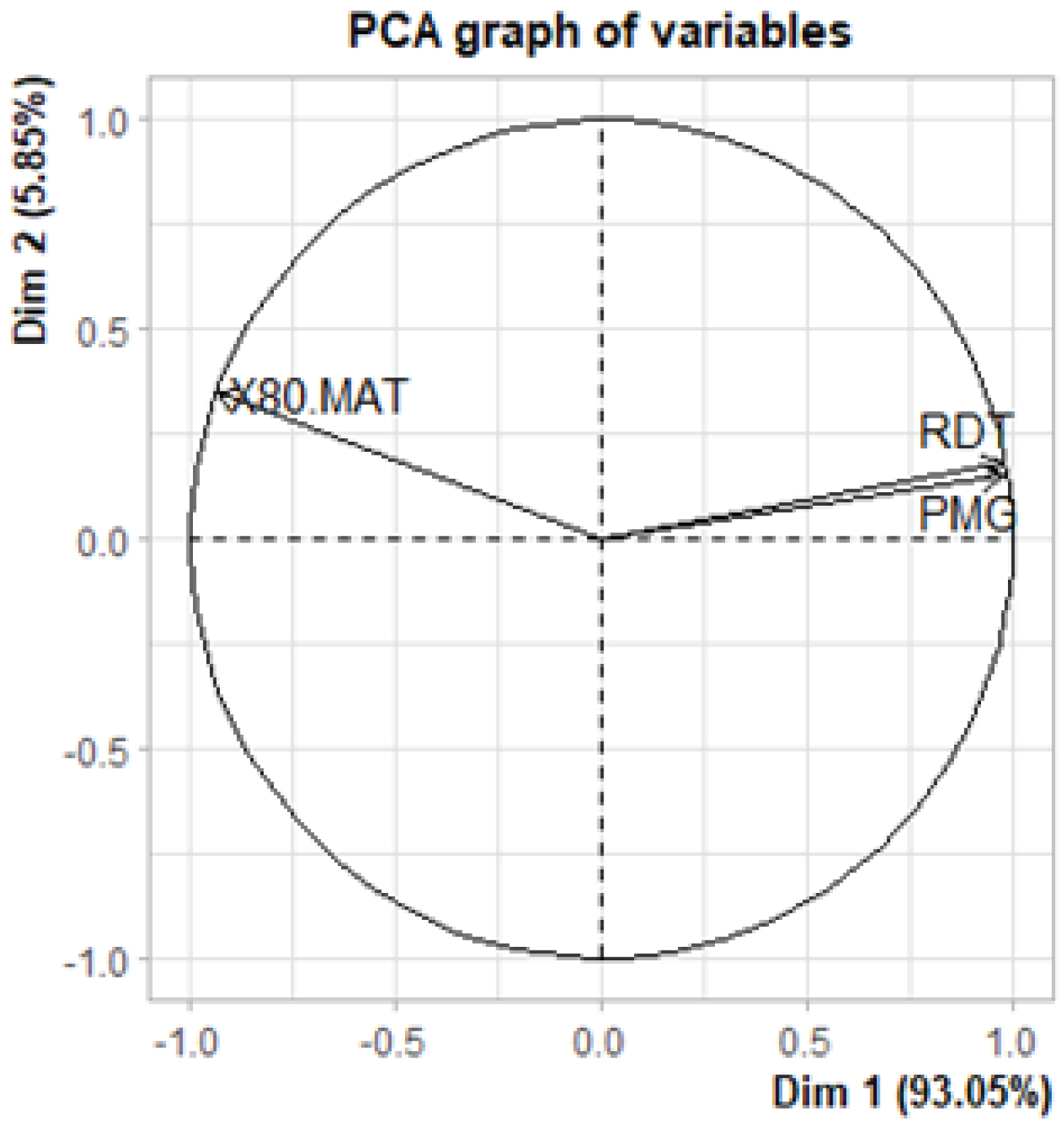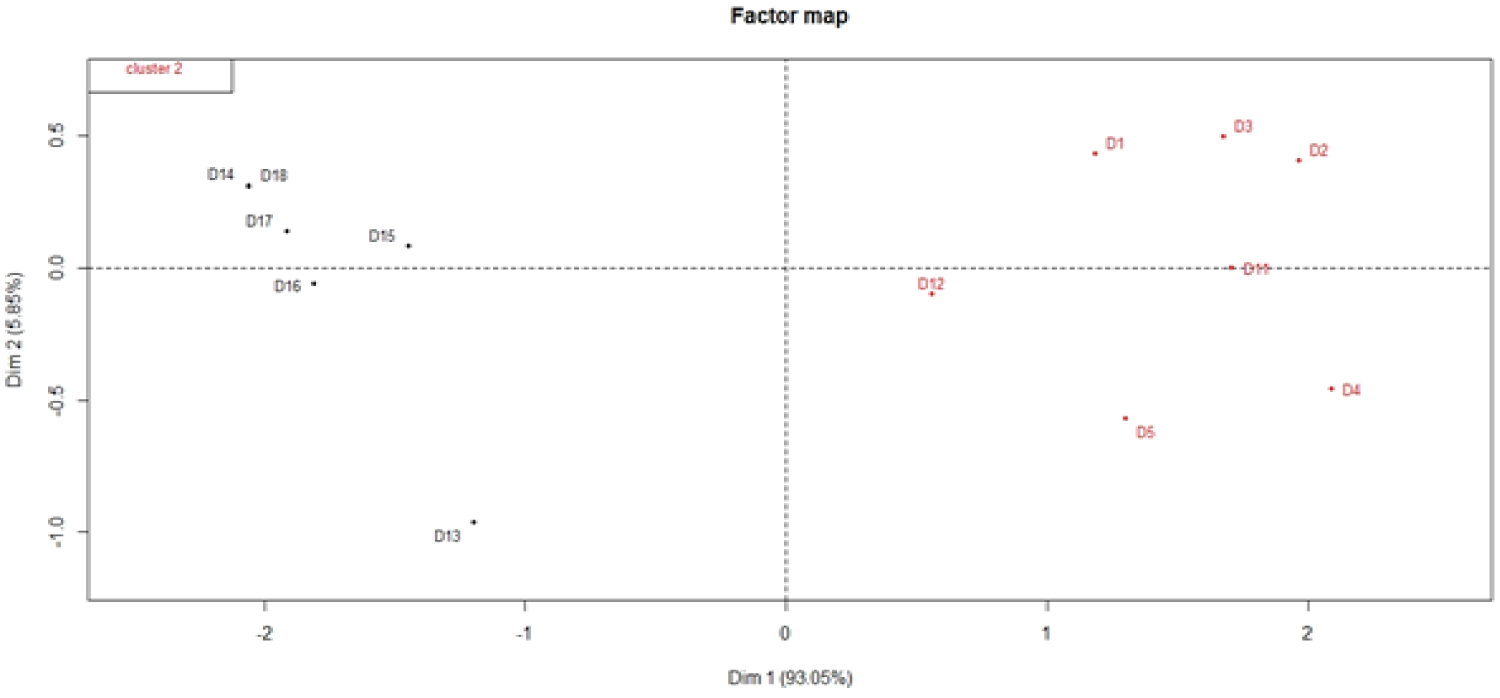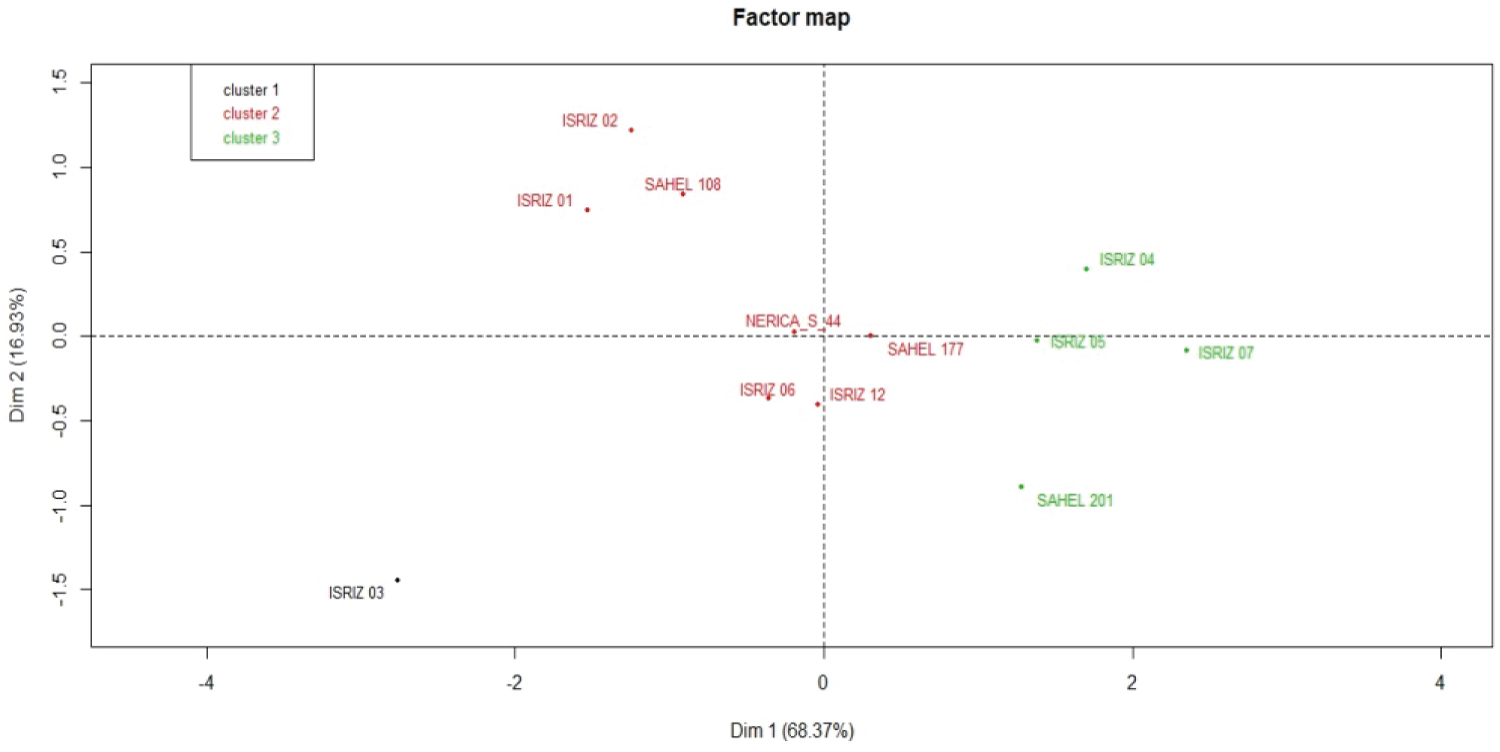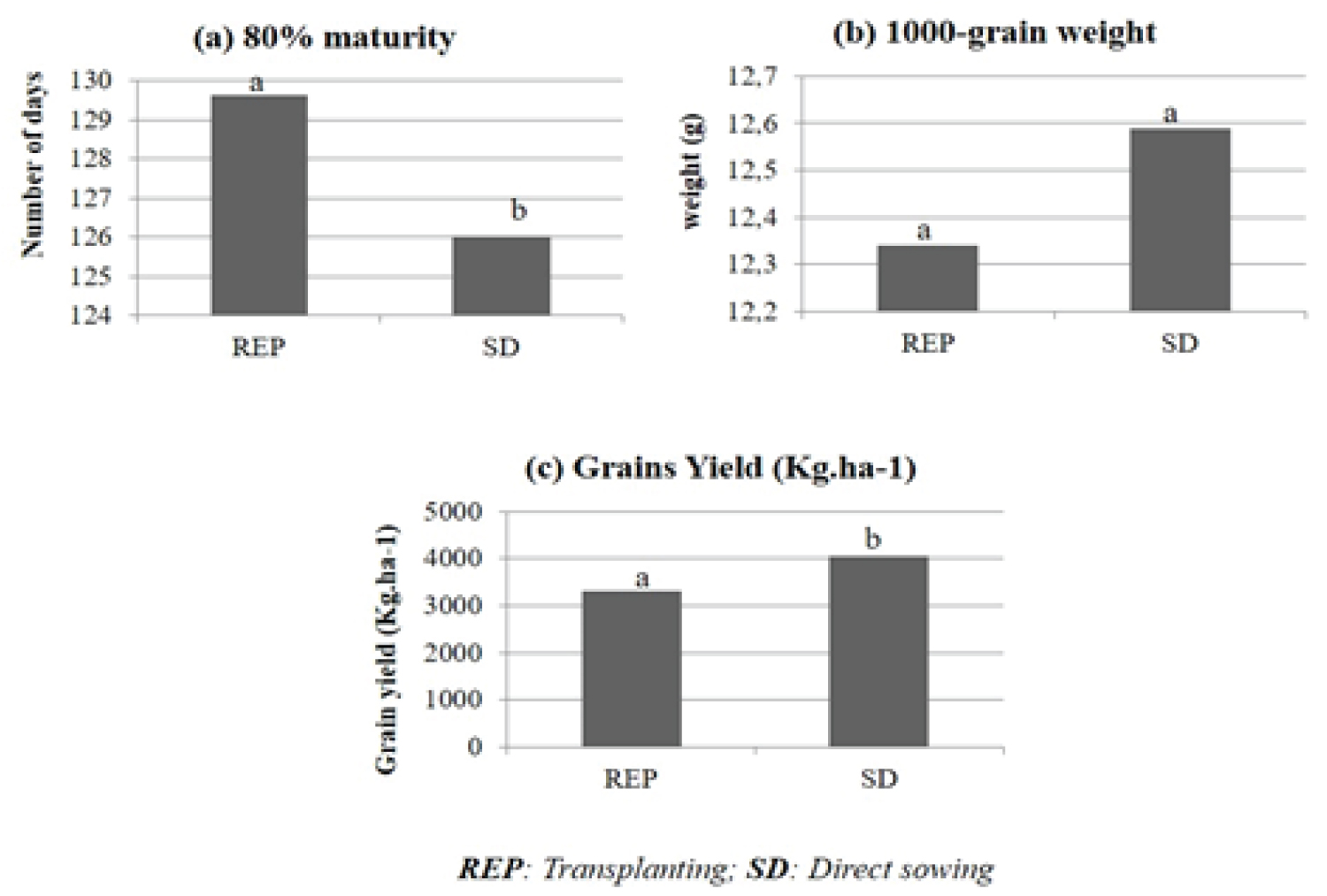Study of the Effect of Sowing Date and Sowing Method on Yield of New Rice Varieties in the Senegal River Valley under Low Temperatures
Abstract
Irrigated rice cultivation has a prominent place in the Senegal River Valley, with the double-cropping system based on old varieties. However, in a context of climatic variability, the system shows limitations in relation to production requirements, resulting a negative impact on rice yields. Therefore, a study was conducted to evaluate the effects of sowing date and sowing method on the yield of some varieties during the low-temperature periods of the year between december and february. A split-split plot design was set up with to sowing modes and a staggered sowing every three weeks for twelve months to define the favourable production periods of eight new rice varieties. Observations and measurements were made on the cycle at 80% maturity, 1000 grain weight and yield at 14% moisture. The results of this study showed that beyond the choice of variety, the choice of the sowing date is very important. For the off-season campaign, the best sowing date was 23 january with a yield of over 9 T.ha -1 compared to sowing between february and march, which is the control period. For wintering, the best sowing period is between mid-july and the beginning of august, while sowing in october-december leads to a slowdown in growth and a drop in yield of up to 00 Kg.ha -1 . Although the seeding method does not statistically influence the yield, but the best yields were obtained in direct seeding mode. The study identified high yielding varieties suitable for double cropping rice in the area.
Keywords
Rice, Sowing date, Yield, Temperature
Introduction
Rice has ( Oryza sativa L) nowdays become a staple food for a large part of the world’s population [1,2]. Its production occupies about 11% of the world’s land area [3]. In West Africa, rice is a strategic product for food security [4]. Consumption of rice in West Africa has increased rapidly since the 1960s as a result of population growth, increased per capita consumption and urbanisation [5]. Production in 2021/2022 in Sub-Saharan Africa is expect to decline as the main rice growing regions have experienced periods of drought, or flooding in some areas during the growing season. As results, local supply is expected to remain limited and import forecasts indicate a new record of nearly 20 million tonnes or 40% of world trade; to make up the production deficit [6]. In Senegal, average annual rice consumption has varied since 2014 between 93 Kg and 108 Kg per capita, and the share of national production in consumption will have risen from 26% in 2014 to 42% in 2019 [7]. To address the rice production deficit in West Africa, the regional authorities adopted in 2014 the Regional Rice Offensive to produce 25 million tonnes by 2025 [8]. Thus, many countries have launched programs in recent years to ensure their self-sufficiency, following the example of Senegal, which has apted for the intensification of rice cultivation; which was previously rainfed, by introducing double irrigated rice cultivation in the Senegal River Valley (SRV), which has a hydro agricultural potential estimated at 240 000 hectares and provides 60% of the national production. However, the double rice crop faces several difficulties such as climatic variability, which is manifested by heat and cold sequences, a lengthening of the off-season and a delay in the onset of the winter season [9] and the technical package, wich results in the use of varieties that have shown their limits in a context of climatic variability. Rice is a thermophilic plant and finds optimal conditions for photosynthesis at temperatures of 25 °C to 35 °C (indica) or 20 °C to 33 °C (japonica) [10]. Although it can adapt to a wide range of temperatures, at certain phases of its phenology, rice is sensitive to temperature peaks (cold and heat). This often requires an appropriate choice of varieties and sowing dates to allow the variety to better express its yield potential. It appears necessary to study the adaptaion of new rice varieties to climatic trends in the Senegal River Valley. Thus, we hypothesised that ther would be new varieties with high production potential among the ISRIZ varieties released by the Senegalese Institute of Agricultural Research. To varify this hypothesis, this study was conducted with the overall objective of increasing production and contributiong to the improvement of food security. To this end, the study aims to determine the optimal sowing period and best varieties with high yield potential to facilitate the implementation of double cropping of rice in the Senegal River Valley.
Materials and Methods
Study environment
The experiment was carried out at the Experimental Station of the Agricultural Research Center of the Senegalese Institute of Agricultural Research in Fanaye (16°33N and 15°46W) (Figure 1). The soil profile at Fanaye belongs to a vertisol. The soil hosting the trial is characterised by a content of at least 6.5 mg C kg -1 soil and 4 mg P kg -1 (P-Bray1). The climatic of the site is characterised by a rainy season with an average of 200 mm of rainfall per year from july to october, a cold dry season from november to february and a hot dry season from march to june [11].
Plant material
The planting material is composed of twelve varieties of various origins (Table 1). Four registered varieties (Nerica_S_44; Sahel 108; Sahel 177; Sahel 201) were chosen as controls because of their good adaptation in the Valley (representing more than 95% of the sown area in the the Valley). The seeds used were producted by the Agricultural Research Center of Saint-Louis.
Methodology
A split-split plot design was used (Figure 2) The factors stydied: (i) Variety with tzelve modalities; (ii) Sowing method with two modalities (transplanting and broadcasting) and (iii) Sowing date with thirteen modalities (sowing carried out every twenty-one days from January 2017 to december 2017).
Each sowing date was treated as an individual experiment, although consecutive sowing dates were adjacent. Table 2 shows the different sowing dates.
Crop management
Soil preparation: The soil was worked after pre-irrigation with double pass offset discs, about 10-15 cm deep, and mechanical levelling. This was essential for water management, weed control and good distribution of fertilisers.
Pre-sprouting of seeds
Pre-sprouting of seeds was done in two phases (soaking and incubation) in order to trigger the germination process. Soaking consisted of immersing the seeds in a cloth bag for 24 hours in a container filled with water. This allowed the soaked seeds to absorb the amount of water needed to trigger the germination process. After 24 hours of soaking, the seeds were incubated underground at a temperature of about 30 °C for 24 hours until germination. At the end of this time, the seeds germinated well. From november onwards, when the minimum temperature was below 18 °C, the incubation time was 48 hours, instead of the usual 24 hours.
Sowoing method
In broadcasting (direct sowing), the quantity of seed used was 80 kg.ha -1 , i.e. 40 g of seed per 5m² (5m * 1m) elementary plot. In nursery sowing, the quantity of seed used was 40 Kg.ha -1 , i.e. 20 g of seed sown in trays. Transplanting was done twenty-one days in the nursery on elementary plots of 5 m 2 (5m * 1m) with a spacing of 20 cm by 20 cm.
Fertilisation of the experimental plots
NPK nutrient requirements, estimated at 120-60-60 per unit were applied; DAP (18-46-00) as a base fertilizer and urea (46-00-00) as a cover fertilizer. Urea was applied in two fractions, 50% at the beginning of tellering and 50% at panicle initiation. And potassium (60 Kg.ha -1 ) in the form of KCl.
Water management in the plots
Irrigation was done as needed, on average twice a week and according to the development phases of the rice. A 5 cm to 10 cm water blade in the vegetative phase; a 10 cm to 15 cm water blade in the reproduction phase. In the maturation phase, the water level is gradually reduced until be plots are dry one to two weeks before harvest. The quality of irrigation and drainage is an essential factor in making the most of the fertilizers applied.
Parameters studies
Temperature data were collected at the Fanaye weather station during the entire experimental period.
The number days from sowing to 80% plant maturity (80% MAT): The date when 80% of the plants in the elementary plot have reached maturity was noted. The cycle length is obtained by taking the difference between the two dates.
80% MAT = Difference between sowing date and 80% maturity date
1000 grain weight (PMG)
After threshing the yield square (in each plot, a small unit of 0.5m * 0.5m was delimited to form the yield square), 1000 full grains were counted using a grain counter and the weight was taken using an electronic scale.
Yield at 14% humidity (RDT)
The yield for each elementary plot was determined according to formula (i).
(i);
Where PL/m² = number of plants per square; Pan/plant = number of panicles per plant; G/Pan = total number of grains per panicle; %FG = percentage of filled grains per panicle; PMG = weight of a thousand filled grains; 10 -7 conversion unit.
Finally, this yield was adjusted to 14% moisture according to formula (ii).
(ii);
Where THM is the measured moisture content
Data processing
The analysis of variance was carried out on the different factors (sowing date; sowing method and variety) and the interaction of these factors on the parameters studied. Statistical analyses were carried out on the variables studied using GenStat software. All analyses were performed at the 5% level and in case of significant differences, multiple comparisons of means were performed using the Tukey [12]. Principal component analysis and hierarchical classification were carried out with R.
Results and Discussion
Study of the evolution of temperatures during the experiment
Minimum temperatures ranged from 12.39 °C to 22.86 °C from January 2017 to April 2018 (Figure 3). The lowest temperatures were recorded in December-January 2017. The same trend was observed in 2018. From February onwards, a gradual increase in temperature was noted, with a peak between June and August 2017 (24 °C and 26 °C), before decreasing to 12.39 °C in January 2018. The maximum temperature varied between 28.75 °C and 38.79 °C with peaks between June and October (36 °C and 38.79 °C). Finally, the average temperature varied between 20.41 °C and 30.12 °C. According to these temperature trends, the best sowing period for the off-dry season is from 5 February to 5 March and the rainy season from 5 July to 10 August.
Effect of the sowing date on 80% maturity; 1000 grian weight and grain yield
The analysis of variance of the observed parameters according to sowing date, sowing method and variety as well as the interactions is presented in the following Table 3.
Sowing date has a significant effect on maturity; 1000-grain weight and grain yield of rice. Indeed, sowing between January and March where the minimum temperature is below 20 °C, the sowing-maturity cycle is around 120 days (Table 3). However, the semi-maturity cycle has decreased and is around 100 days for sowing between march and august, when the minimum temperature is above 20 °C. From September to December (D13 to D18) when the minimum drops to 12 °C, the maturity cycle reached 160 days. The sowing date as well as the temperature have a great influence on the development cycle of rice. The optimum temperature for growth is between 22 and 31 °C, and requires 5 to 6 hours of sunlight per day [13-15]. The weight of 1000 grains remained constant for sowing from January to March in the off-dry season and at the beginning of August for sowing in the winter season where the minimum temperature is above 20 °C respectively; this confirms the results of Tanveer, et al., [16] who found that the observed 1000 grain weight did not vary using different sowing dates, sowing rates and sowing date * sowing rate interactions. However, during sowing periods (September to December) when the minimum temperature is around 12 °C, the 1000 grains weight becomes zero. This shows that environmental conditions such as temperature and humidity influence grain filling. Similar results were found by Bashir, et al.; Biswas & Salokhe; Dhaliwal, et al.; Lu & Cai; Majid, et al., [17-21] who showed that 1000 grains weight decreases progressively with low temperature sowing periods. Similarly, the later sowing, the more the 1000 grain weight decreases [22]. As for grain yield, it is significantly affected by the sowing date. The best grain yield (9362.18 t.ha -1 ) was observed at the sowing date of 23 January for the off-season campaign. After this sowing date, grain yields decreased. The comparison of the average yields according to the date is significantly different (p < 0.001). The yield observed for the sowing on 23 January corresponding to D2 was higher than the yield observed for the sowing on 5 January. On the other hand, the yields observed for sowing between February and March, which is the sowing period following by the producers and recommended by the current cropping calendar, were lower than the yield observed for sowing on 23 January. In winter, the period from mid-july to early august was the optimal sowing period when good yields (6964.94 t.ha -1 ) were observed. These yields were higher than those obtained for sowing after mid-august, which was the normal sowing period for producers and recommended by the current cropping calendar. On the other hand, the yields observed fro sowing between September and December were almost zero. At this time of the year, environmental conditions were unfavorable, which caused a high sterility of the spikelets. According to Wopereis, et al., [23], sterility can reach 100% if the minimum air temperature falls below 16 °C. From September 2017 to April 2018, the minimum temperature falls below 20 °C and even fell 12 °C in January. This period of low temperatures coincided with the reproductive phase of the rice causting high sterility, which explains the almost zero yield corresponding to the sowings from september to december. Razafindrazaka, et al., [13] showed that the sowing date affects the grain yield of rice. The effect of sowing date on grain yield was also demonstrated in the case of maize studies by Chhetri, et al., [24]. Principal component analysis and hierarchical clustering were performed to characterise the sowing dates on the basis of 80% maturity; 1000 grain weight and grain yield. These parameters, summarised by two axes (Figure 4), provide 98.9% of the information recorded. The 1000-grain weight and grain yield are correlated on axis 1, which means that an increase in 1000 grain-weight results in an increase in grain yield. Maturity at 80%, is correlated with axis 2 and negatively with 1000-grain weight and the yield are reduced; however, the time between sowing and maturity depends on the temperature and therefore on sowing date [25]. Thus the difference sowing dates have been grouped into two classes (Figure 5). The first class: This gathers the sowings of september-december (D13 to D18), period when the minimum temperature goes from 25 °C to 12 °C; this confirms the results of van Oort, et al., [25], which showed that in the current context of the valley, the sowing of September-November presents risks of almost total loss of harvest due to the cold. And the second class 2 composed of the sowing of January-August (D1 to D12), period when the minimum temperature increases from 12 °C to 26 °C; which is adequate for the proper development of rice. According to van Oort, et al., [25] the January-June seedlings offer high yields (more than 9 t.ha -1 ), which is in line with our results.
Effect of the variety on the 80% maturity date, the weight of 1000 grains and the grain yield
It has been observed that the variety significantly affects the date of maturity at 80% (Table 4). This could be due to the intrinsic character of each variety and allows them to be classified into short-cycle varieties (ISRIZ 01; ISRIZ 02; ISRIZ 03; Sahel 108 and NERICA-S-44), middle cycle (ISRIZ 04; ISRIZ 05; ISRIZ 06; ISRIZ 07; ISRIZ 12 and Sahel 177) or long cycle (Sahel 201). On the other hand, the day of 80% maturity of these varieties was significantly affected by the sowing dates. These results corroborate those of Nadim, et al.; Sabouri, et al., [26,27] which showed variations in maturity date at 80% for different rice genotypes. In periods of low temperatures, the varietal cycle lengthens and the varieties do not reach maturity or have grain sterility. Only the early maturing varieties escape the damage caused by the cold. Statistical analyses on the weight of 1000 grains, did not show a significant difference between varieties (Table 4).
The maximum weight of 1000 grains (14.7 g) was obtained by ISRIZ 07 and the minimum weight (12.02 g) was obtained by ISRIZ 02. On the other hand, the environmental conditions related to each sowing date can significantly affect the weight of 1000 grains. Temperature, soil fertility also have an effect on grain size and filling [28]. The data showed that the different varieties of rice do not have a significant effect on grain yield (Table 4). But the varieties were significantly affected by the date of sowing. However, variety ISRIZ 07, gave the maximum grain yield (4169.98 Kg) and variety ISRIZ 03 gave the minimum grain yield (2553.26 Kg). These observed yields are below the potential yield of the varieties tested. This difference, called the yield gap, would be due to the fact that the observed yield was obtained according to all planting dates. However, sowing from September to December had recorded zero yields. According to Nadim, et al., [26], Rice productivity is the rate at which it accumulates organic matter that depends mainly on the rate of photosynthesis and the conversion of light energy into chemical energy by rice plants. In periods of low temperatures, the rate of photosynthesis decreases and the rate of accumulation of organic matter is low; which affects the filling of the grains leading to a decrease in yield. These results are consistent with those of Khattak, et al., [29] who showed that the variety has no effect on grain yield, but this yield is significantly affected by planting dates. The classification carried out to characterize the varieties according to the parameters made it possible to series the varieties into three classes (Figure 6).
Class 1 consisting only of the variety ISRIZ 03 is intermediate to the other two classes according to the cycle, but has a low yield. Class 2: Varieties ISRIZ 01, ISRIZ 02, ISRIZ 06, ISRIZ 12, NERICA_S_44, SAHEL 108 and SAHEL 177 constitute this group. These varieties are short cycle and can be the subject of the double cultivation of rice in the Senegal River Valley. Class 3: it is composed of 4 varieties that are ISRIZ 04, ISRIZ 05, ISRIZ 07 and SAHEL 201 which are characterized by a medium or long cycle. Although these varieties have a good yield, they cannot be grown once in the year.
Effect of sowing mode on 80% maturity date, weight of 1000 grains and grain yield
The analysis of the 80% maturity date and yield showed a significant effect while the weight analysis of 1000 grains showed a non-significant effect (Figure 5). Transplant transplantation has an effect on the maturity date of rice varieties and yield compared to direct sowing on the fly [28,30,31]. The effect of the transplant date could be due to the transplantation shock, which would have lengthened the cycle of varieties (Figure 7).
Conclusion
These short-cycle varieties adapt better to valley conditions than older varieties that are beginning to show limits. The results of this study have shown that the performance of these new varieties is intrinsically linked to the date of sowing whether in the off-dry season or in wintering. Thus, of the thirteen sowing dates, only sowing between the second half of January and the first half of March (against the dry season) allowed the varieties to express their potentiality in terms of yield, whose best varieties are ISRIZ 02 ISRIZ 05 and ISRIZ 07 whose yields were respectively 11282.75 Kg.ha -1 ; 9663.45 Kg.ha -1 and 10091.82 Kg.ha -1 . Similarly, sowing between the second half of July and the first half of August (wintering) yielded better. Finally, it is retained, whatever the variety and the method of sowing, the best yields were obtained in direct sowing.
References
- Ahmadi N, Bouman B (2013) Riz et rizicultures, enjeux economiques, ecologiques et scientifiques. Cahiers Agricultures 22: 333-335.
- Yo OBS, Baco NM, Labiyi IA, et al. (2020) Effets environnementaux et production de nouvelles sources energiques de la biomasse issue du riz: Cas de letuvage du riz au CePEA Sourou au Nord-Ouest du Benin. International Journal of Applied Research 6: 309-316.
- Wani SA, Qayoom S, Bhat MA, et al. (2017) Effect of varying sowing dates and nitrogen levels on growth and physiology of scented rice. Oryza 54: 97-106.
- Soullier G, Demont M, Arouna A, et al. (2020) The state of rice value chain upgrading in West Africa. Global Food Security 25.
- Mendez del Villar P, Lancon F (2015) West African rice development: Beyond protectionism versus liberalization? Global Food Security 5: 56-61.
- Mendez del Villar P (2022) Rapport mensuel sur le marche mondial du riz-Janvier 2022 n°215 (n°215; p.3).
- Agrisen (2021) Evolution de la production et des importations de riz au Senegal-Rechercher.
- Pays (2020) Understand the agricultural market in sub-Saharan Africa in 9 key points: The irrigated perimeter of the zone Office du Niger provides close to 30% of the #rice consumed by Mali-Rechercher.
- thiao M, Larbi A (2022) Analysis of the situation of pluvial agriculture in the south of Senegal. Revue Marocaine des Sciences Agronomiques et Vétérinaires 10.
- Yoshida S (1981) Fundamentals of Rice Crop Science, International Rice Research Institute, Los Banos. Laguna.
- Haefele SM, Wopereis MCS, Schloebohm AM, et al. (2004) Long-term fertility experiments for irrigated rice in the West African Sahel: Effect on soil characteristics. Field Crops Research 85: 61-77.
- Tukey JW (1949) Comparing Individual Means in the Analysis of Variance. Biometrics 5: 99.
- Razafindrazaka A, Stuerz S, Cotter M, et al. (2020) Genotypic yield responses of lowland rice in high-altitude cropping systems. Journal of Agronomy and Crop Science 206.
- Majid A, Ahmad SI, Saeed MA (1989) Effects of different direct sowing techniques and date of sowing on rice production. J Agric Mech Asia 20: 19-22.
- Wang J, Vanga S, Saxena R, et al. (2018) Effect of Climate Change on the Yield of Cereal Crops: A Review. Climate 6: 41.
- Yao F, Huang J, Cui K, et al. (2012) Agronomic performance of high-yielding rice variety grown under alternate wetting and drying irrigation. Field Crops Research 126: 16-22.
- Tanveer SK, Hussain I, Asif M, et al. (2009 ) Performance of different wheat varieties/lines as affected by different planting dates and seeding rates under high rainfall area of Potohar. Pak J Agri Sci 46: 102-106.
- Bashir MU, Akbar N, Iqbal A, et al. (2010) Effect of different sowing dates on yield and yield components of direct seeded coarse rice (Oryza sativa L). Pak J Agri Sci 47: 361-365.
- Biswas PK, Salokhe RM (2001) Tiller dynamics and yield of parent and clonal plant of transplanted rice. Doctor of Technical Science dissertation. Asian Institute of Technology, Thailand.
- Dhaliwal YS, Nagi HP, Sidhu GS, et al. (1986) Physicochemical, milling and cooking quality of rice as affected by sowing and transplanting dates. Journal of the Science of Food and Agriculture 37: 881-887.
- Lu K, Cai M (2000) Characteristics of growth and development and high yield cultivation technology in intermediate season hybrid rice II You501. Journal of Huazhong Agricultural University 19: 91-94.
- Mahmood N, Hussain A, Akhtar B, et al. (1995) Effect of transplanting date and irrigation on rice paddy yield. Sci Tech Dev 14: 49-52.
- Wopereis MCS, Defoer T, Idinoba P, et al. (2009) Manual technique. Reference 11: The effects of temperature on the development of rice. Researcher.
- Chhetri S, Poudel A, Kandel BP, et al. (2018) Effect of sowing dates on grain yield and other agronomic traits of different maize inbred lines. Int J Sci Eng Res 9: 428-434.
- van Oort PAJ, Saito K, Drame KN (2019) Exploring adaptation options to climate change for irrigated rice in Africa.
- Nadim MA, Awan IU, Baloch MS, et al. (2012) Response of wheat (Triticum aestivum L.) to different micronutrients and their application methods. J Anim Plant Sci 22: 113-119.
- Sabouri H, Rabiei B, Fazlalipour M (2008) Use of Selection Indices Based on Multivariate Analysis for Improving Grain Yield in Rice. Rice Science 15: 303-310.
- Reza F, Hamid RM, Abbas AD, et al. (2011) The effect of planting date and seedling age on yield and yield components of rice (Oryza sativa L.) varieties in North of Iran. African Journal of Agricultural Research 6: 2571-2575.
- Khattak SI, Nadim MA, Baloch MS, et al. (2016) Impact of variable seeding dates on cereals’ performance under agro-ecological conditions of dera ismail khan. Pakistan Journal of Agricultural Research 29.
- Goita O, Traore K, Diwara B, et al. (2017) Etude de l'effect de la date of semis et de l'age des plantules au repiquage sur le rendement of three varieties of rice adoptees dans les perimetres irrigues villageois des regions de Tombouctou et de Gao. Agronomie Africaine 29: 11-17.
- Inamullah NH, Shah ZH, Fu K (2007) An analysis of the planting dates effect on yield and yield attributes of spring wheat. Sarhad J Agric 23: 269-275.
Corresponding Author
Koffi Marchais KITTIKA, Department of Plant Production and Agronomy, Faculty of Agricultural Sciences Aquaculture and Food Technology, Gaston Berger University, Senegal.
Copyright
© 2023 KITTIKA KM, et al. This is an open-access article distributed under the terms of the Creative Commons Attribution License, which permits unrestricted use, distribution, and reproduction in any medium, provided the original author and source are credited.

